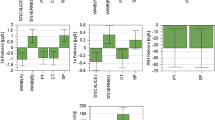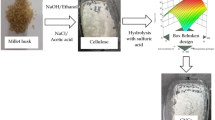Abstract
Eucalyptus globulus wood samples were treated with NaOH solutions in order to obtain substrates highly susceptible to enzymatic hydrolysis. The experiments performed in the extraction and hydrolysis stages followed an incomplete factorial design. Temperature, NaOH concentration and extraction time were considered as independent variables. Their influence on five dependent variables (defined to measure the extraction yield, the chemical composition of processed samples and the enzymatic conversion) was assessed using second order, empirical models. In addition to the experimental results, other aspects related to the extraction selectivity are discussed.
Similar content being viewed by others
References
Myerly, R. S.; Nicholson, M. D.; Katzen, R.; Taylor, J. M.: The forest refinery. Chemtech (1981) 186–192
Rijkens, B. A.: Hydrolyses processes for lignocellulosic material. In: CECD Workshop Cellulose Programme. Braunschweig, 1984
Koukios, E. G.; Valkanas, G. N.: Process for the chemical separation of the three main components of lignocellulosic biomass. Ind. Eng. Chem. Prod. Res. Dev. (1982) 309–314
Johansson, A.; Aaltonen, O.; Ylinen, P.: Organosolv lignin pulping. Methods and pulp properties. Biomass (1987) 45–65
David, G; Fornassier, R.; Lejong, W.; Vanlautem, N.: Pretreatment of Eucalyptus wood with sodium hypochloryte and enzymatic hydrolysis with cellulases of Trichoderma viride. J. Appl. Polym. Sci. (1988) 29–41
Browning, B. L. In: Methods of Wood Chemistry. John Wiley & Sons. New York, 1967
Vázquez, G.; Antorrena, G.; Parajó, J. C.: Studies on the utilization of Pinus pinaster bark. 1. Chemical constituents. Wood Sci. Technol. (1987) 65–74
Vázquez, G.; Parajó, J. C.; Antorrena, G.; Thonart, Ph.; Paquot, M.: Sugars from pine bark by enzymatic hydrolysis: Effect of sodium chlorite treatments. Wood Sci. Technol. (1987) 167–178
Mandels, M.; Andreotti, R.; Roche C.: Measurement of saccharifying cellulose. Biotechnol. Bioeng. Symp. (1976) 21–33
Paquot, M.; Thonart, Ph.: Hydrolyse enzymatique de la cellulose regenerée. Holzforschung (1982) 177–181
Dillner, B.; Ljunger, O.; Herud, A.; Thune-Larsen, E.: The breeding of Eucalyptus globulus on the basis of wood density, chemical composition and growth rate. Symp. Prod. Ind. Util. Eucalyptus. Lisbon, March, 1970
Poirier, M. G.; Ahmed, A.; Grandmaison, J. L.; Kaliaguine, S. C. E: Supercritical gas extraction of wood with ethanol in a tubular reactor. Ind. Eng. Chem. Res. (1987) 1738–1743
Vázquez, D.; Lage, M. A.; Parajó, J. C.; Vázquez, G.: Fractionation of Eucalyptus wood in acetic acid media. Biores. Technol. (in press)
Simionescu, C. I.; Popa, V. I.: Contribution to the valorification of beech wood bark. Cellul. Chem. Technol. (1987) 279–287
Akhnazarova, S.; Kafarov, V., In: Experiment optimization in Chemistry and Chemical Engineering. MIR Publishers. Moscow, 1982
Box, G. E. P.; Hunter, W. G.; Hunter, J. S., In: Estadistica para investigadores. Ed. Reverté. Barcelona, 1988
Author information
Authors and Affiliations
Rights and permissions
About this article
Cite this article
Parajó, J.C., Alonso, J.L., Lage, M.A. et al. Empirical modeling of eucalyptus wood processing. Bioprocess Engineering 8, 129–136 (1992). https://doi.org/10.1007/BF01254228
Received:
Issue Date:
DOI: https://doi.org/10.1007/BF01254228




